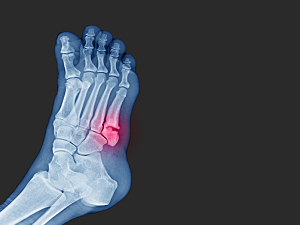Over the past century, numerous authors and groups have suggested classification systems for fifth metatarsal base fractures, a common foot injury. The subtle differences between them have led to confusion about standard nomenclature in the literature and clinical practice.
Christopher P. Chiodo, MD, section chief of the Foot and Ankle Surgery Service at Brigham and Women’s Hospital, and colleagues recently surveyed foot and ankle surgeons to evaluate the reliability of current classification systems for fifth metatarsal base fractures. In Foot & Ankle International, they recommend limiting classification to two types, which constitutes a simpler approach that is more reliable and predictive of the need for surgery.
Methods
The researchers sent an online survey to the American Orthopaedic Foot and Ankle Society listserv, asking for voluntary participation. Surgeons could view anteroposterior, oblique, and lateral radiographic views of 18 fractures, chosen to represent a mix of zone 1, 2, and 3 injuries based on the Lawrence and Botte classification published in Foot & Ankle International.
Viewing of Radiographs
223 surgeons responded, first answering questions about the radiographs:
Jones fracture—Surgeons were asked whether each fracture was a Jones fracture. Inter-rater agreement was moderate (κ, 0.533; 95% CI, 0.530–0.535).
Zones 1/2/3—In randomized order, surgeons saw the images again and were asked to identify them as zone 1, 2, or 3 fractures without directing what classification should be used. Inter-rater agreement was again moderate (κ, 0.537; 95% CI, 0.535–0.539).
Metaphyseal/meta-diaphyseal—The surgeons were presented with a diagram of the two-zone classification described by Polzer and colleagues in Injury. They then viewed the images again and answered whether each fracture was metaphyseal or meta-diaphyseal. Inter-rater agreement was substantial (κ, 0.705; 95% CI, 0.702–0.708).
Questions About Clinical Practice
The surgeons also answered several questions about the clinical management of fifth metatarsal base fractures:
- Respondents were shown an unlabeled schematic of two three-zone classifications; when asked which system is typically used in practice to classify fifth metatarsal base fractures, 58% chose the classification by Lawrence and Botte, and 42% chose the one by Dameron in the Journal of AAOS.
- When surgeons were asked, “What do you consider a Jones fracture (multiple select),” 85% chose zone 2, 78% chose zone 2–3 junction, 33% chose zone 3, 26% chose zone 1–2, and 0.7% chose zone 1
- When asked whether they treat patients with symptomatic fractures in zone 2 and zone 3 in the same way, 70% of respondents replied affirmatively
Conclusion
In addition to Polzer and colleagues, Chuckpaiwong and colleagues previously suggested in Clinical Orthopaedics and Related Research limiting the classification of fifth metatarsal base fractures to two types, based on similar outcomes for treatment of Jones fractures and treatment of proximal diaphyseal fractures. The results of this survey support that recommendation.
